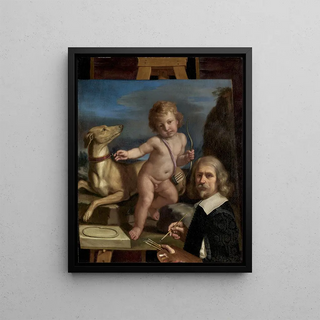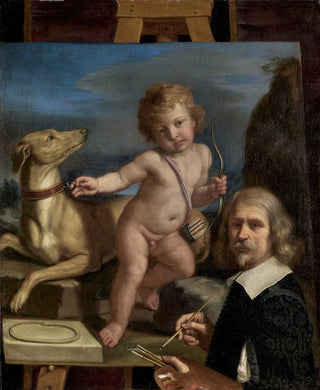Art print | Self-portrait in front of a painting by Amor Fedele - Guercino


View from behind

Frame (optional)
In the fascinating world of Baroque art, the art print "Autoportrait devant un tableau d'Amor Fedele" by Guercino stands out for its narrative depth and expressiveness. This piece, which captures the very essence of the artist, invites us to delve into the intimacy of his creative universe. The self-portrait, a genre that has long fascinated artists, becomes here a revealing mirror of Guercino's emotions and reflections. The scene, where the artist depicts himself in front of his own creation, evokes a meeting between the creator and his work—a delicate dance between art and artist. This painting, both personal and universal, offers us an entry point into understanding the human soul through the lens of art.
Style and uniqueness of the work
Guercino's work is characterized by a unique style, where light and shadow intertwine with remarkable mastery. In "Autoportrait devant un tableau d'Amor Fedele," the chiaroscuro emphasizes the features of the artist's face while highlighting the details of the painting he presents. This striking contrast creates an atmosphere that is both dramatic and contemplative, inviting the viewer to question the relationship between art and its creator. The colors, carefully chosen, evoke a rich and vibrant palette, where each nuance seems to tell a story. This art print is not merely a simple representation; it is a celebration of creativity, an invitation to explore the depths of the artistic spirit.
The artist and his influence
Giovanni Francesco Barbieri, known as Guercino, is one of the masters of Italian Baroque. Born in 1591, he established himself as a leading artist thanks to his innovative approach and undeniable talent. Influenced by Caravaggio and the great masters of his time, Guercino developed a style that is uniquely his own, blending realism and expressiveness. His work, rich in emotion, has left a mark on many artists and continues to inspire current generations. In "Autoportrait devant un tableau d'Amor Fedele," he does not

Matte finish

View from behind

Frame (optional)
In the fascinating world of Baroque art, the art print "Autoportrait devant un tableau d'Amor Fedele" by Guercino stands out for its narrative depth and expressiveness. This piece, which captures the very essence of the artist, invites us to delve into the intimacy of his creative universe. The self-portrait, a genre that has long fascinated artists, becomes here a revealing mirror of Guercino's emotions and reflections. The scene, where the artist depicts himself in front of his own creation, evokes a meeting between the creator and his work—a delicate dance between art and artist. This painting, both personal and universal, offers us an entry point into understanding the human soul through the lens of art.
Style and uniqueness of the work
Guercino's work is characterized by a unique style, where light and shadow intertwine with remarkable mastery. In "Autoportrait devant un tableau d'Amor Fedele," the chiaroscuro emphasizes the features of the artist's face while highlighting the details of the painting he presents. This striking contrast creates an atmosphere that is both dramatic and contemplative, inviting the viewer to question the relationship between art and its creator. The colors, carefully chosen, evoke a rich and vibrant palette, where each nuance seems to tell a story. This art print is not merely a simple representation; it is a celebration of creativity, an invitation to explore the depths of the artistic spirit.
The artist and his influence
Giovanni Francesco Barbieri, known as Guercino, is one of the masters of Italian Baroque. Born in 1591, he established himself as a leading artist thanks to his innovative approach and undeniable talent. Influenced by Caravaggio and the great masters of his time, Guercino developed a style that is uniquely his own, blending realism and expressiveness. His work, rich in emotion, has left a mark on many artists and continues to inspire current generations. In "Autoportrait devant un tableau d'Amor Fedele," he does not






